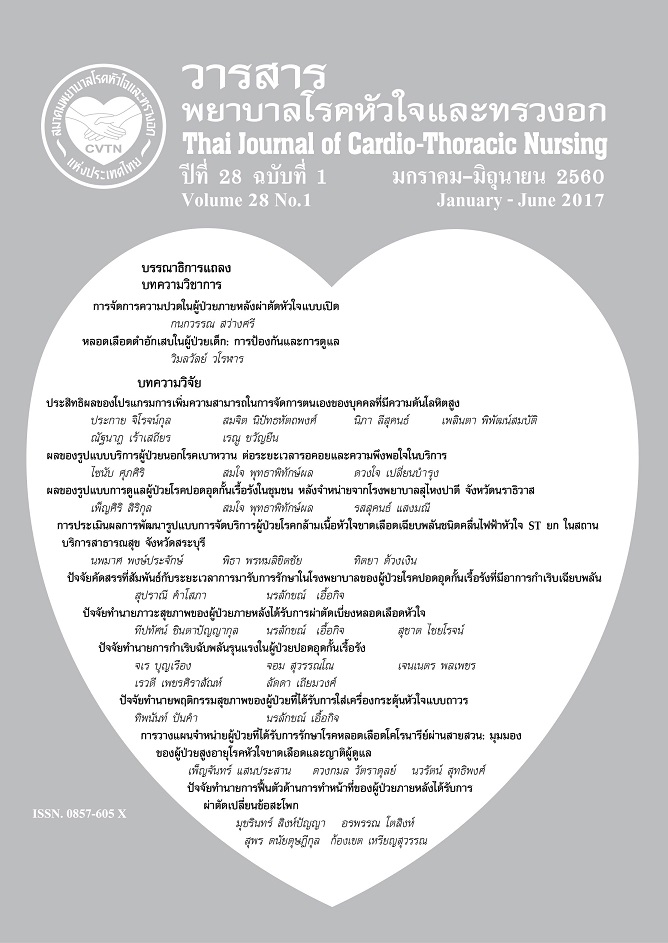ผลของรูปแบบการดูแลผู้ป่วยโรคปอดอุดกั้นเรื้อรังในชุมชน หลังจำหน่ายจาก โรงพยาบาลสุไหงปาดี จังหวัดนราธิวาส
Keywords:
การเยี่ยมบ้าน, การกำเริบของโรคเฉียบพลัน, การเข้ารักษาซ้ำก่อน 28 วัน, ผู้ป่วยโรคปอดอุดกั้นเรื้อรัง, home health care, acute exacerbations, readmission, chronic obstructive pulmonary disease (COPD)Abstract
การวิจัยแบบกึ่งทดลองนี้ มีวัตถุประสงค์เพื่อศึกษาผลของการใช้รูปแบบการดูแลผู้ป่วยโรคปอดอุดกั้นเรื้อรังในชุมชน หลังจำหน่ายจากโรงพยาบาลสุไหงปาดี จังหวัดนราธิวาส ต่ออัตราการได้รับการเยี่ยมบ้าน อัตราการกำเริบของโรคเฉียบพลัน และอัตราการเข้ารักษาซ้ำก่อน 28 วัน
กลุ่มตัวอย่างในการศึกษาครั้งนี้ได้แก่ อาสาสมัครสาธารณสุขประจำหมู่บ้าน ในอำเภอสุไหงปาดี จำนวน 50 คน และผู้ป่วยโรคปอดอุดกั้นเรื้อรังที่เข้ารับการรักษาในแผนกผู้ป่วยในและจำหน่ายจากโรงพยาบาลสุไหงปาดี ในช่วงเวลาที่ทำการศึกษาวิจัย จำนวน 41 คน เป็นกลุ่มทดลอง 17 คนได้รับการดูแลตามปกติ และกลุ่มควบคุม 24 คนได้รับการดูแลโดยใช้รูปแบบการดูแลผู้ป่วยโรคปอดอุดกั้นเรื้อรัง เครื่องมือที่ใช้ในการวิจัย ได้แก่ คู่มือการดูแลสุขภาพผู้ป่วยโรคปอดอุดกั้นเรื้อรังสำหรับอาสาสมัครสาธารณสุขประจำหมู่บ้าน แบบทดสอบความรู้เกี่ยวกับการดูแลผู้ป่วยโรคปอดอุดกั้นเรื้อรัง และสมุดบันทึกประจำตัวผู้ป่วยโรคปอดอุดกั้นเรื้อรัง วิเคราะห์ข้อมูลด้วยสถิติเชิงพรรณนา ได้แก่ จำนวน ร้อยละ ค่าเฉลี่ย ส่วนเบี่ยงเบนมาตรฐาน สัดส่วน และ Z-test
ผลการวิจัยพบว่าอัตราการได้รับการเยี่ยมบ้าน ของผู้ป่วยโรคปอดอุดกั้นเรื้อรัง ในกลุ่มทดลอง สูงกว่ากลุ่มควบคุม อย่างมีนัยสำคัญทางสถิติ (P<0.05) แต่อัตราการกำเริบของโรคเฉียบพลัน ของผู้ป่วยโรคปอดอุดกั้นเรื้อรัง ระหว่างกลุ่มทดลอง และกลุ่มควบคุม ไม่แตกต่างกันอย่างมีนัยสำคัญทางสถิติ (P<0.05) และอัตราการเข้ารักษาซ้ำก่อน 28 วัน ของผู้ป่วยโรคปอดอุดกั้นเรื้อรัง ในกลุ่มทดลอง ต่ำกว่ากลุ่มควบคุม อย่างมีนัยสำคัญทางสถิติ (P<0.05)
การวิจัยครั้งนี้เสนอแนะให้มีการนำรูปแบบการดูแลผู้ป่วยโรคปอดอุดกั้นเรื้อรังในชุมชนโดยการมีส่วนร่วมของชุมชนเพื่ออัตราการเข้ารักษาซ้ำก่อน 28 วันในผู้ป่วยโรคเรื้อรัง
The effect of caring model for patients with chronic obstructive pulmonary disease in the community after discharge from Sungaipadi hospital, Narathiwas province
The purposes of this quasi-experimental research were to examine the effects of caring model for patients with chronic obstructive pulmonary disease (COPD) in the community after discharge from Sungaipadi Hospital, Narathiwas Province on home health care rate, acute exacerbations rate and readmission rate.
The sample consisted of fifty Village Health Volunteers of Sungaipadi district Narathiwat Province and forty-one patients with COPD who discharged from Sungaipadi Hospital. The sample were divided into the control group (24 patients) receiving usual care while the experimental group (17 patients) receiving caring model for patients with COPD. The research instruments developed by researcher were the home health care guideline for patients with COPD, knowledge about caring for patients with COPD test, and personal health record for patients with COPD. Data were analyzed by percentage, mean, standard deviation, proportion and Z-test.
The results showed that the patients with COPD in the experimental group received home health care rate were significantly higher than those in control group. However, acute exacerbations rate of the patients with COPD among experimental group and control group were no significantly differences. Lastly, the readmission rate of the patients with COPD in the experimental group were significantly lower than those in the control group.
This study has suggested that a caring model for patients with COPD should be applied by promote community participation to decrease readmission rate.
Downloads
How to Cite
Issue
Section
License
บทความนี้ยังไม่เคยตีพิมพ์หรืออยู่ในระหว่างส่งไปตีพิมพ์ในวารสารอื่น ๆ มาก่อน และกองบรรณาธิการขอสงวนสิทธิ์ในการตรวจทาน และแก้ไขต้นฉบับตามเกณฑ์ของวารสาร ในกรณีที่เรื่องของท่านได้ได้รับการตีพิมพ์ในวารสารฉบับนี้ถือว่าเป็น ลิขสิทธิ์ของวารสารพยาบาลโรคหัวใจและทรวงอก






